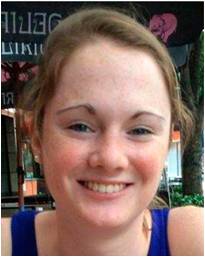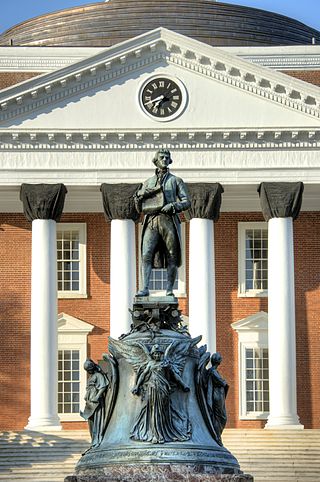Related Research Articles

Charlottesville, colloquially known as C'ville, is an independent city in Virginia, United States. It is the seat of government of Albemarle County, which surrounds the city, though the two are separate legal entities. It is named after Queen Charlotte. At the 2020 census, the population of the city was 46,553. The Bureau of Economic Analysis combines the City of Charlottesville with Albemarle County for statistical purposes, bringing its population to approximately 160,000. Charlottesville is the heart of the Charlottesville metropolitan area, which includes Albemarle, Buckingham, Fluvanna, Greene, and Nelson counties.

The Rotunda is a building located on The Lawn on the original grounds of the University of Virginia. Thomas Jefferson designed it to represent the "authority of nature and power of reason" and modeled it after the Pantheon in Rome. Construction began in 1822 and was completed shortly after Jefferson's death in 1826. The campus of the new university was unique in that its buildings surrounded a library rather than a church, as was common at other universities in the English-speaking world. To many, the Rotunda symbolizes Jefferson's belief in the separation of church and education, and represents his lifelong dedication to education and architecture. The Rotunda was designated a National Historic Landmark in 1966, and is part of the University of Virginia Historic District, designated in 1971.

Madison Hemings was the son of the mixed-race enslaved woman Sally Hemings and, according to most Jefferson scholars, her enslaver, President Thomas Jefferson. He was the third of her four children to survive to adulthood. Born into slavery, according to partus sequitur ventrem, Hemings grew up on Jefferson's Monticello plantation, where his mother was also enslaved. After some light duties as a young boy, Hemings became a carpenter and fine woodwork apprentice at around age 14 and worked in the joiner's shop until he was about 21. He learned to play the violin and was able to earn money by growing cabbages. Jefferson died in 1826, after which Sally Hemings was "given her time" by Jefferson's surviving daughter Martha Jefferson Randolph.

Alexander Rives was a Virginia attorney, politician and plantation owner. He served in both houses of the Virginia General Assembly, as a justice of the Supreme Court of Virginia and as a United States district judge of the United States District Court for the Western District of Virginia.
Mary Hemings Bell was born into slavery, most likely in Charles City County, Virginia, as the oldest child of Elizabeth Hemings, a mixed-race slave held by John Wayles. After the death of Wayles in 1773, Elizabeth, Mary, and her family were inherited by Thomas Jefferson, the husband of Martha Wayles Skelton, a daughter of Wayles, and all moved to Monticello.
Canada was a small community of free African-Americans established near the University of Virginia in Charlottesville in the 19th century. Many residents of Canada were employed by the university. The community existed from the early 19th century until the early 20th century, by which time the increasingly valuable land had been purchased by white speculators. Researchers theorize that the community was named in homage to the country bordering the United States to the north, where slavery had been abolished under the Slavery Abolition Act of 1833.
Thomas Jefferson, the third president of the United States, owned more than 600 slaves during his adult life. Jefferson freed two slaves while he lived, and five others were freed after his death, including two of his children from his relationship with his slave Sally Hemings. His other two children with Hemings were allowed to escape without pursuit. After his death, the rest of the slaves were sold to pay off his estate's debts.

Morgan Dana Harrington was a 20-year-old Virginia Tech student who disappeared from the John Paul Jones Arena while attending a Metallica concert at the University of Virginia (UVA) in Charlottesville, Virginia.

Slavery in Virginia began with the capture and enslavement of Native Americans during the early days of the English Colony of Virginia and through the late eighteenth century. They primarily worked in tobacco fields. Africans were first brought to colonial Virginia in 1619, when 20 Africans from present-day Angola arrived in Virginia aboard the ship The White Lion.

Fountain Hughes was an American former slave freed in 1865 after the American Civil War. Born in Charlottesville, Virginia, he worked as a laborer for most of his life, moving in 1881 from Virginia to Baltimore, Maryland. He was interviewed in June 1949 about his life by the Library of Congress as part of the Federal Writers' Project of former slaves' oral histories. The recorded interview is online through the Library of Congress and the World Digital Library.

The history of the University of Virginia opens with its conception by Thomas Jefferson at the beginning of the early 19th century. The university was chartered in 1819, and classes commenced in 1825.

Hannah Elizabeth Graham was an 18-year-old second-year British-born American student at the University of Virginia who went missing on September 13, 2014. She was last seen early in the morning that day, at the Downtown Mall in Charlottesville, Virginia. Five weeks later, her remains were discovered on an abandoned property in nearby Albemarle County. Jesse Matthew pleaded guilty to murdering Graham and was sentenced to life imprisonment. He was also found guilty and given three additional life sentences for other, previous crimes.
Court Square Park is a public park in Charlottesville, Virginia.
The Charlottesville historic monument controversy is the public discussion on how Charlottesville should respond to protesters who complain that various local monuments are racist. The controversy began before 2016 when protest groups in the community asked the city council for the local removal of Confederate monuments and memorials. Other monuments became part of the controversy, including those of Thomas Jefferson because of his ownership of slaves and those of Lewis and Clark for their advocacy of white colonists over Native Americans.

Thomas Jefferson is a statue of U.S. Founding Father and president Thomas Jefferson in front of the Rotunda at the University of Virginia, the university he founded and designed. The statue was crafted by Moses Ezekiel in 1910 and was a copy of the Jefferson statue in Louisville, Kentucky.
John Henry James was an African-American man who was lynched near Charlottesville, Virginia on July 12, 1898, for having allegedly raped a white woman. James had no known family in the area, and had lived in Charlottesville for only five or six years. He was an ice cream seller; "nothing else is known of him."

The Memorial to Enslaved Laborers is a memorial in honor of those enslaved African Americans who built and worked at the University of Virginia, in Charlottesville, Virginia.

Maurie D. McInnis is an American author and cultural historian. She currently serves as the 6th president of Stony Brook University.

Isabella Gibbons was an enslaved woman serving as a cook at the University of Virginia, in Charlottesville, Virginia. After liberation in 1865 she became a teacher.

Sally Cottrell Cole was an enslaved maid and seamstress who worked at Monticello and the University of Virginia.
References
- ↑ "Charlottesville to honor Liberation and Freedom Day, not Thomas Jefferson's birthday". WVIR-TV (NBC29.com). July 3, 2019. Archived from the original on July 14, 2019. Retrieved July 14, 2019.
- ↑ Davis, Moriah (March 3, 2019). "Charlottesville Celebrates Liberation and Freedom Day on UVA Grounds". WVIR-TV (NBC29.com). Archived from the original on May 1, 2019. Retrieved July 14, 2019.
- ↑ Bromley, Anne E. (March 3, 2019). "UVa Commemorates Enslaved Laborers at 'Liberation and Freedom Day' Ceremony". UVa Today. Archived from the original on July 15, 2019. Retrieved July 15, 2019.
- ↑ Freedman, Emmy (January 9, 2019). "UVA to Recognize Lives of Enslaved People with New Memorial Marker". WVIR-TV (NBC29.com). Archived from the original on June 30, 2019. Retrieved July 14, 2019.
- ↑ "University of Virginia boosts funding for slavery memorial". WTOP-FM. Associated Press. September 4, 2018. Archived from the original on July 14, 2019. Retrieved July 14, 2019.
- ↑ "Liberation and Freedom Day". Virginia Humanities. February 15, 2019.[ permanent dead link ]